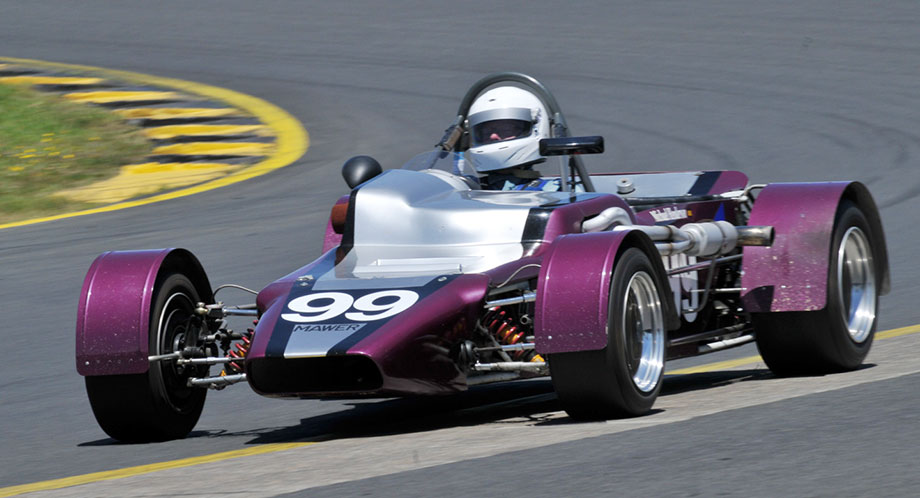
1960 Lotus 7A Series 1

This 1960 Lotus Seven was my first racing car. Colin Chapman was the founder of Lotus and the inspiration for the company and its racing team for his whole life. The Seven was the first production version of what became known as the “Clubman” category of road sports and racing cars, becoming the mainstay of the company in its early days. Derivatives of the general style – lightweight, functional and rather stark, with cycle wings – are still popular today.
Chapman was keen to expand the market for Lotus cars in the United States, among other countries, and “my” car was one of the very first production Series 1 Lotus Sevens, powered by a BMC A-series engine. I was close to the company and its (few!) senior personnel, and co-wrote a book on its early history (Lotus: The Story of the Marque, MRP 1961). I suggested to Chapman that it might help publicity if I wrote a series of stories in the motorsport press on building a Seven up from a kit - the way it was sold those days, to avoid UK sales tax) - and into road and race condition. He agreed, and with the essential assistance of two other medical student friends assembled the car in a little north London garage. In early 1960 I drove my first race in the road-registered Lotus at Brands Hatch, coming in second place.
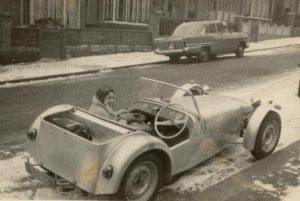
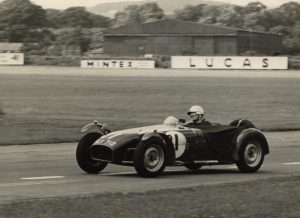
Norma and I went and competed at many race meetings that year, with continuing success. The car did not have a hood, so in inclement weather Norma used to snuggle down under the tonneau cover, sometimes with the gearbox cover cracked open to let warm air into the car!
Part of the publicity deal was the production of a documentary called Seven Story, the tale of a young man (played by me) and his girlfriend (Norma) building a Seven and finally racing it.
At the end of the year I had a test in a Lotus open-wheeled Formula Junior racing car, but there was a far more serious need to finalise my medical training and any dreams of more racing for the time being went by the board. But a strong seed was duly sown.
1965/66 Mallock U2 Mk6 Clubman
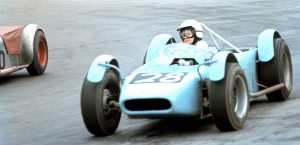 After returning from a tour of duty in Cyprus, in 1967 I returned to racing with another Clubman category car. The Mallock line of racing cars was initiated in 1958 by Major Arthur Mallock, an intuitive engineer who was one of the first to truly understand the kinetics of racecar suspension.
After returning from a tour of duty in Cyprus, in 1967 I returned to racing with another Clubman category car. The Mallock line of racing cars was initiated in 1958 by Major Arthur Mallock, an intuitive engineer who was one of the first to truly understand the kinetics of racecar suspension.
In the Clubman category, which became very popular in the UK during the 1960s, they became the cars to beat. Like mine, most were powered by the Ford Cortina-based 1500cc pre-crossflow engine, and the super-lightweight chassis frame made for a spirited car.
 The U2 was much faster round the circuit than the Lotus Seven, given similar engines, but it was rather harder to get the most out of the car. With the car on a trailer this time, for two years Norma and I again travelled all over the UK, racing on all the significant circuits, having fun but not with any great success. We mostly camped in a pup tent in the paddock, accompanied by our three-year-old daughter Anita. When the cars were called to the starting grid, she usually had to rush to the loo!
The U2 was much faster round the circuit than the Lotus Seven, given similar engines, but it was rather harder to get the most out of the car. With the car on a trailer this time, for two years Norma and I again travelled all over the UK, racing on all the significant circuits, having fun but not with any great success. We mostly camped in a pup tent in the paddock, accompanied by our three-year-old daughter Anita. When the cars were called to the starting grid, she usually had to rush to the loo!
It was in the U2 that I was able to first demonstrate the use of the six-point configuration for the racing driver's harness, which I had designed. I was at that time one of the only drivers in Europe to wear any kind of restraint, but had developed a bit of a reputation through my articles on safety in the motorsport press.
In the popular Clubman category there were constant minor upgrades, urged upon us by the major. So, the faster cars were usually driven by those better able to afford them, including one of my regular competitors, Max Mosley (later the President of the FIA).
1965 Elva-BMW 7S
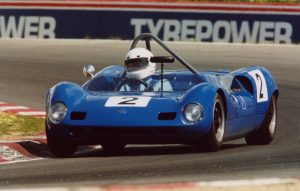 During 1965 and 1966 this beautiful Elva BMW Mark 7S was raced very successfully in Britain by Keith St John. With the works car driven by Tony Lanfranchi, it was one of the two best-known Elva BMWs in period and a car I yearned to own
During 1965 and 1966 this beautiful Elva BMW Mark 7S was raced very successfully in Britain by Keith St John. With the works car driven by Tony Lanfranchi, it was one of the two best-known Elva BMWs in period and a car I yearned to own
It was also one of the first cars in Britain ever to carry sponsorship, being supported by Radio London, an early “pirate” commercial radio station. It was generally known as the “Radio London” car.
The car is one of only 15 similar models that were built with the powerful BMW 2-litre engine in full race configuration.
I first bought the car from the Radio London team in 1967, and brought it out to Australia with us in February 1968. I raced it at the NSW circuits such as Warwick Farm, Catalina Park Katoomba and Oran Park, but the financial and time demands of a new job were in conflict with any real success. I sold it in late 1970, and it then passed through various configurations until being discovered and beautifully restored by Ian McDonald in 1986.
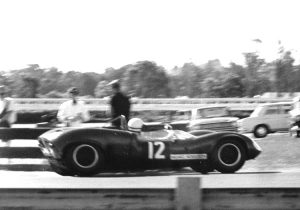
I bought the Elva back in 1998 and with it for the second time I was much more successful in its new life, breaking many historic category sports car lap records in Australia. It wasn't the easiest car to drive quickly, but I loved the strong engine and brilliant acceleration, quite apart from its graceful looks. However, in 2012 I accepted a good offer from an experienced racer in the UK, so it returned "home" and is now racing in many prestigious events including the Goodwood Revival.
It's a bit late for regrets, but I miss this car now; it would have suited me well in my declining years!
1969 Lotuz Clubman
 After returning with Norma from our eight years of voyaging around the world, I decided to return to motor racing. This time I joined the increasingly popular Historic racing category, which in Australia includes all kinds of competition cars dating from the pre-WW1 years to the late eighties. The category is popular because of the wide variety of cars, the spirited but relatively careful competition - vehicle-to-vehicle contact is taken to be a serious matter - and the easy access by spectator enthusiasts to the vehicles and their drivers. The general concept is that the cars and their history are more important than winning races, but most of us tend to forget that when out on the track among others!
After returning with Norma from our eight years of voyaging around the world, I decided to return to motor racing. This time I joined the increasingly popular Historic racing category, which in Australia includes all kinds of competition cars dating from the pre-WW1 years to the late eighties. The category is popular because of the wide variety of cars, the spirited but relatively careful competition - vehicle-to-vehicle contact is taken to be a serious matter - and the easy access by spectator enthusiasts to the vehicles and their drivers. The general concept is that the cars and their history are more important than winning races, but most of us tend to forget that when out on the track among others!
With due regard to my early history, I decided to put my toe back in the water with another car of the Clubman category. This time, it was to be a Lotus Seven copy, with several improvements over the baseline car. It was called by its designer-builder the "Lotuz", and as at the time he was working on Clubman cars built by Nota, an Australian rival to the Lotus cars, its name did cause something of a confusion.
After a good deal of modification and testing I developed it into a very pleasant little race car, powered by the popular Ford Cortina engine in a moderate state of tune. It was easy to handle and turned out to be highly competitive in the Clubman class, winning the local Clubman championship in 1993. It was also generally quick among other cars in the same age category.
1974 Birrana 374 Australian Formula Two
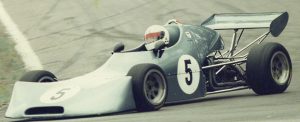 The next step was to move into a class of car that was new to me, but to which I had always aspired: a single-seat open formula car.
The next step was to move into a class of car that was new to me, but to which I had always aspired: a single-seat open formula car.
So, in 1993, I chose a Birrana, a well-known name in Australia. The first Birrana was a Formula Ford built by Tony Alcock in 1971 for John Goss. Alcock was a designer-builder who had previously worked for Brabham, Cosworth, McLaren and Cooper. "Birrana" is an Australian aboriginal word meaning "throwing stick".
Alcock was a skilled and innovative man, predicted to have a bright future in international motor sport. He joined Graham Hill's Embassy Formula One team, but died with Hill and other team members when the light aircraft piloted by Hill crashed in bad weather conditions.
All his cars were a delight to drive, as was my version. The model was designated as a 374 (Formula 3) car, but was also run as a Formula 2 car, the configuration of mine. It had a downdraft head on a Holbay Ford-based engine, powerful for its size but hard to keep in tune. The car's aerodynamics and its handling were so good that it could run with nominally much faster cars, such as Formula Atlantic ( to which I moved later). It was probably the easiest car to drive fast that I have ever owned, and an excellent introduction to the single-seater field.
1959 Lotus Eleven Le Mans
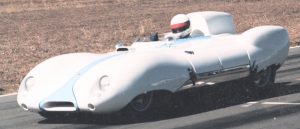 I have always been interested in the Lotus company, its history and its race and road cars. I started racing in a Lotus Seven. In late 1955 Clin Chapman decided that the company's efforts would be concentrated on one model only. This would be known as the "Eleven", a sports-racing car powered by the lightweight Coventry Climax engine. It came to dominate the 1,100cc category in sports car racing, ranging from small club events to long distance international events. More than 150 were built. In 1956 the range was expanded to embrace the Le Mans version, with Climax engines up to 1,460cc, and simpler "Club" models with Ford motors and simpler suspensions.
I have always been interested in the Lotus company, its history and its race and road cars. I started racing in a Lotus Seven. In late 1955 Clin Chapman decided that the company's efforts would be concentrated on one model only. This would be known as the "Eleven", a sports-racing car powered by the lightweight Coventry Climax engine. It came to dominate the 1,100cc category in sports car racing, ranging from small club events to long distance international events. More than 150 were built. In 1956 the range was expanded to embrace the Le Mans version, with Climax engines up to 1,460cc, and simpler "Club" models with Ford motors and simpler suspensions.
Back in 1956 a friend of mine in England raced an Eleven, and I vowed to myself that one day I would have an Eleven. But at no point from then on through the decades could I afford one, as their value steadily rose with time. On a 1993 business trip to the United States, however, I was browsing a classic competition car showroom, and asked a salesman whether he knew of an Eleven in poor condition that could be a possible project for restoration. He put me in touch with a local collector with an extraordinary barn full of restoration projects. They included, down the back, an Eleven that he had crashed, followed by a fire. I bought the wreck, but would not have done so had he not had up in the loft a complete new aluminium bodywork set that he had intended to use in the restoration - which he would never have got round to.
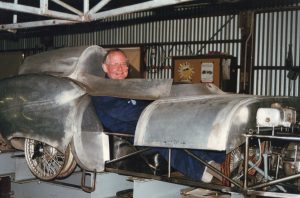 I shipped the whole package back to Sydney in 1994, and had the car rebuilt in Sydney by the best restorer in Australia, Herb Neal. The result was a car that would have won any concours event in the world. As chassis number 547, it was one of the last Elevens to be built, and was for a long time "lost" to Lotus historians. I was pleased to be able to re-establish its provenance and significance. Sadly, in a way, by the time it was finished I was racing some very fast cars, and following a test session I was thereafter very reluctant to take the car on the track. My mechanic said it was so perfect he was frightened to touch it! So I sold this gorgeous car to a friend who would go on to enjoy the car in a non-competitive manner. It was later in a car museum and thence passed on to other classic vehicle collectors.
I shipped the whole package back to Sydney in 1994, and had the car rebuilt in Sydney by the best restorer in Australia, Herb Neal. The result was a car that would have won any concours event in the world. As chassis number 547, it was one of the last Elevens to be built, and was for a long time "lost" to Lotus historians. I was pleased to be able to re-establish its provenance and significance. Sadly, in a way, by the time it was finished I was racing some very fast cars, and following a test session I was thereafter very reluctant to take the car on the track. My mechanic said it was so perfect he was frightened to touch it! So I sold this gorgeous car to a friend who would go on to enjoy the car in a non-competitive manner. It was later in a car museum and thence passed on to other classic vehicle collectors.
1977 Lola T-560 Formula Atlantic
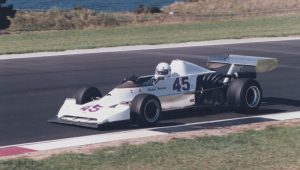 I got increasingly competitive when driving the Birrana in the fastest categories in historic racing in Australia, and decided to look for a car to the Formula Atlantic specifications. In 1976 race authorities in the USA and Canada created Formula Atlantic as a less expensive alternative to the European formulas, such as Formula Two. Identical rules were defined for Formula Pacific, as it was called in Australia, New Zealand and East Asia. In 1983 the FIA, the world body for motor sport, combined the two under the Formula Mondial ("world") denomination.
I got increasingly competitive when driving the Birrana in the fastest categories in historic racing in Australia, and decided to look for a car to the Formula Atlantic specifications. In 1976 race authorities in the USA and Canada created Formula Atlantic as a less expensive alternative to the European formulas, such as Formula Two. Identical rules were defined for Formula Pacific, as it was called in Australia, New Zealand and East Asia. In 1983 the FIA, the world body for motor sport, combined the two under the Formula Mondial ("world") denomination.
The specifications for the cars were strict, and the engine was universally the Cosworth BDA ("Belt Drive Assembly", in Cosworth-speak), a Ford-based 16-valve twin overhead cam producing about 230 bhp at 9,500 rpm. Although several manufacturers in many countries built their own versions the cars were extremely similar. This meant that drivers' abilities made a substantial difference. World class drivers that came to prominence in these cars in the later ye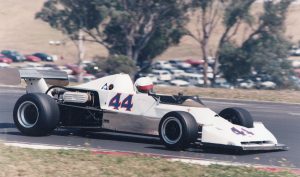 ars of the formula (see my Ralt RT4 description below) included Gilles Villeneuve, Keke Rosberg, Roberto Moreno, Australia's Alan Jones, and Nelson Piquet.
ars of the formula (see my Ralt RT4 description below) included Gilles Villeneuve, Keke Rosberg, Roberto Moreno, Australia's Alan Jones, and Nelson Piquet.
My Lola T-560 was about the last Atlantic built before the rules were changed to allow "ground effect" aerodynamics. I bought it on a 1995 business trip to the USA, during a period when such "modern" cars did not have a race category for historic (vintage) in America. This meant they were hard to sell over there and mine was something of a bargain. It was an immediate success for me, and I won the first race in which it was entered in Australia.
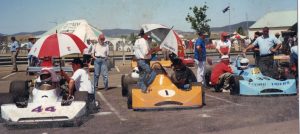
I loved driving that car. It was very fast, a front-runner in its category, yet quite forgiving on the limit. I sold it rather reluctantly in 2000 with an even faster car in mind, but happily to a close friend. He has continued racing it successfully ever since.
1982/86 Ralt RT4 Formula Atlantic
 This Ralt RT4 is a 1982 model with several 1986 updates, originally constructed by Ralt Engineering Limited, Sutton. The company was set up by the Australian, Ron Tauranac. Ron had been the designer and builder of all the formula cars driven by Jack Brabham and which took him to the world championship. He set up Ralt after Brabham retired, and the company became a substantial manufacturer of racing cars. Ron returned to Australia after selling the company, and became friends with many of us in historic racing here. He could not walk past my (or any other) Ralt without making some comment or suggestion for improving it!
This Ralt RT4 is a 1982 model with several 1986 updates, originally constructed by Ralt Engineering Limited, Sutton. The company was set up by the Australian, Ron Tauranac. Ron had been the designer and builder of all the formula cars driven by Jack Brabham and which took him to the world championship. He set up Ralt after Brabham retired, and the company became a substantial manufacturer of racing cars. Ron returned to Australia after selling the company, and became friends with many of us in historic racing here. He could not walk past my (or any other) Ralt without making some comment or suggestion for improving it!
My Ralt was sold originally in Vancouver, Canada. The second owner, from 1984 to 1987, was Martin S Pang, originally of Seattle. Martin has led a turbulent and well-documented life, and his history is a very interesting backdrop to the history of the car. He was adopted at the age of six months in Hong Kong by a Seattle couple of Chinese heritage. His family, which had fled from Beijing nearly penniless, decided they couldn't afford the baby and gave him up for adoption.
His adoptive parents owned a successful frozen Chinese food company, Mary Pang Food Products Inc. They bought an old warehouse in Seattle, and expanded the business to more than $1 million a year in revenues by the mid-1980s.
As a teen, Martin Pang developed a reputation for recklessness and a love for fast cars and motor racing. (Corresponding with me much later, he expressed his enthusiasm for the Ralt.) He was well paid by the family company, with most of the money going to cars and motor racing. He went through four marriages, all ending in accusations of violence. Nevertheless, he had a reputation as a charmer. He tried setting up his own businesses, but after going bankrupt he was bailed out by his parents. Then the frozen food business itself started to slide, and Martin went further into debt. He developed a plan to burn down the company’s old and disused warehouse, which stood on valuable land, for the insurance money. Following a tip-off, fire officials even placed the warehouse under surveillance, but the watch was discontinued prior to the fire, a failure that was the first of many others by the Fire Department.
On January 5, 1995, four Seattle firefighters died in the fire in the Pangs’ warehouse that was set by Martin Pang. The tragedy triggered criticism of the Seattle Fire Department's training and safety practices, including the fact that the firefighters did not have accurate plans for the structure. Consequently, a floor over a hidden basement collapsed and the firefighters fell through.
An investigation confirmed that the fire was set by Martin Pang in order to collect the insurance and to clear the property for development. He fled to Brazil and could not be extradited for murder, for which he was initially charged. After three years of legal and diplomatic wrangling, Pang was returned to Seattle where he pleaded guilty to four counts of manslaughter. He was sentenced to 35 years in prison. The maximum sentence for the four manslaughter charges was 36 years, but that would have opened the door to an appeal on its severity – and 35 years did not allow for such an appeal.
Survivors of the dead firefighters filed lawsuits charging the City of Seattle with negligence. They won their cases, with awards ranging from $450,000 to $5.6 million. In the one case that went to trial, the jury held the Fire Department 75 percent responsible for the tragedy and Pang 25 percent responsible. It is still a cause celebre in Seattle.
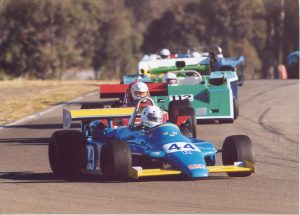 Martin Pang was finally released from prison in September 2018, after 23 years. I initially contacted him in 2001 (through his lawyer) when researching the history of the car, a few years after he was imprisoned. We continued to correspond for about ten years, as he was very interested in our racing, sailing and other travels. I started editing the accounts of our voyaging simply for him. The charm with which he was credited so many years ago came through in his letters, but the history of Martin's life, as opposed to that of the car, clearly had its dark side.
Martin Pang was finally released from prison in September 2018, after 23 years. I initially contacted him in 2001 (through his lawyer) when researching the history of the car, a few years after he was imprisoned. We continued to correspond for about ten years, as he was very interested in our racing, sailing and other travels. I started editing the accounts of our voyaging simply for him. The charm with which he was credited so many years ago came through in his letters, but the history of Martin's life, as opposed to that of the car, clearly had its dark side.
The Ralt RT4 was the final development of Formula Atlantic cars by Ralt, and was basically the same as the models built for the European Formula Two and Three categories. The sea change in design was incorporation of "ground effect", whereby the underside of the chassis and bodywork is shaped like an inverted aerofoil. This "sucks" the car down on to the road surface, giving an astonishing increase in adhesion and roadholding. I bought the car in 1996, and it was the first to be approved for Australia's then new “Group R” historic category for 1978-1986 cars.
Driving these cars is a real challenge, as there is a very abrupt division between the ultimate cornering speed and loss of adhesion and control. This demands some finesse and a smooth driving style, which suited me very well. I managed to secure some very good results with the Ralt, including many category lap records in that period. Then a whole lot of youngsters came into historic racing and started blowing me away . . . I passed it on in 2014.
It was indeed a younger man's car, but I relished the experience. I will never, ever, go round corners faster than I did in the Ralt.
1972 March 722 European Formula 2
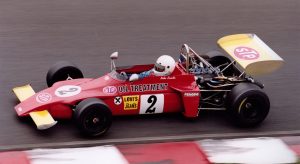 In 2000, it was becoming clear to me that the answer to increasing age and decreasing ability was to procure a more powerful car. I had long aspired to a 2-litre European Formula 2 car, and even dreamed for a while of taking one back to Europe to compete in the historic F2 championship - a dream never fulfilled, for fear of burning up my entire super fund. But I was able to secure a famous F2 car, recently restored and imported to Australia, but little raced. And it had been driven by one of my all-time heroes, Niki Lauda.
In 2000, it was becoming clear to me that the answer to increasing age and decreasing ability was to procure a more powerful car. I had long aspired to a 2-litre European Formula 2 car, and even dreamed for a while of taking one back to Europe to compete in the historic F2 championship - a dream never fulfilled, for fear of burning up my entire super fund. But I was able to secure a famous F2 car, recently restored and imported to Australia, but little raced. And it had been driven by one of my all-time heroes, Niki Lauda.
Niki Lauda, a multiple Formula One World Champion, in his early days drove this works March 722 International Formula Two car, chassis number 5, during the 1972 European season. He succeeded in winning the John Player British F2 Championship.
Lauda was run by STP-March as the number two works driver to Ronnie Peterson. He had borrowed and paid £43,000 – a fortune at the time – for a joint F1/F2 drive as a stepping stone to a Formula One career. The cross insignia on the car is the logo of the bank that lent him the money.
The first race meeting for this March 722-5 was at Mallory Park in March 1972. In his next appearance with the March, Lauda won at a wet Oulton Park, in only the second race win of his career.
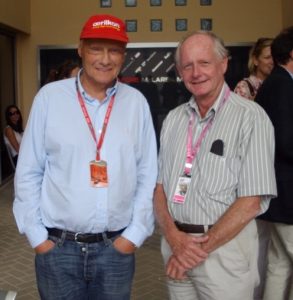
Lauda left March in 1973 for a drive with Louis Stanley’s BRM team, and went on to win the World Championship with Ferrari in 1975 and 1977, and with McLaren in 1984.
The March then went through various configurations, including some time as a hillclimb car. It was then restored in Britain and shipped to Australia by an orthopaedic surgeon from whom Michael acquired it in 2000.
It was restored in accordance with its appearance in 1972 and as driven by Niki Lauda, including STP and other sponsorship decals. Its light chassis is powered by a very strong 300 bhp Cosworth-Ford BDG 1975cc fuel-injected engine.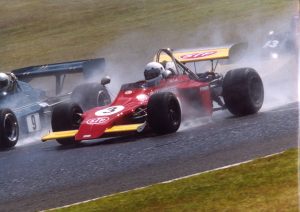
With a power to weight ratio of about 600 bhp per tonne it is a ferociously quick racing car and a blast to drive. I had a fair bit of success with it, but during my ownership it suffered ongoing and expensive problems with reliability - funnily enough, just as Lauda had experienced in period. It is one of the few March 722s running with the correct 2-litre BDG engine. Most have been fitted with the more reliable BDA 1600cc motor.
I loved driving the car when it was going well, but my pockets were not deep enough to continue; so, in 2005 it was passed on to a prominent local collector of historic Formula One and Two cars.
1970 Lotus Europa Series 2
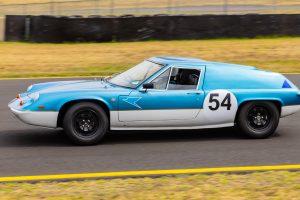 After the Ralt was finally sold in 2014, for the first time for many years I had no competition car in the garage. I had decided that I was retiring from racing, now being in my late 70s. But then, after a couple of years simply attending meetings and socialising with friends, I decided to get back on the track. I thought a good idea would be to try running in less competitive, non speed-dependent events, such as those called "regularity. The idea is to nominate a given lap time, a bit slower than if you were racing, and then - along with a group of similar cars - try to stick as close to that speed for a given period of time, 15 or 20 minutes. This is low-key motorsport, and very popular.
After the Ralt was finally sold in 2014, for the first time for many years I had no competition car in the garage. I had decided that I was retiring from racing, now being in my late 70s. But then, after a couple of years simply attending meetings and socialising with friends, I decided to get back on the track. I thought a good idea would be to try running in less competitive, non speed-dependent events, such as those called "regularity. The idea is to nominate a given lap time, a bit slower than if you were racing, and then - along with a group of similar cars - try to stick as close to that speed for a given period of time, 15 or 20 minutes. This is low-key motorsport, and very popular.
Having been a Lotus enthusiast nearly all my life, and having owned and driven two models, I decided on a mid-engined coupe that could be road registered and even driven to the circuit. This was a 1970 Lotus Europa, Series 2.
The Lotus Europa was a two door mid-engined GT coupé built by Lotus Cars from 1966 to 1975. Typically Lotus light, most were powered by a Renault engine and employed a race-based independent suspension system hung from a backbone chassis. Aside from the doors, bonnet and engine cover, the body was moulded as a single unit of fibreglass. The car's handling prompted automotive writers of the time to describe the Europa as the nearest thing to a Formula car for the road.
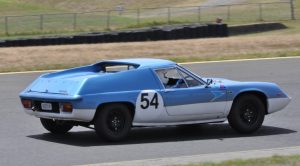 I found one that was in the later stages of development for the kind of low-key track work I was anticipating. It was cramped but comfortable once in, and Norma and I had a few runs on the road, enjoying its excellent handling.
I found one that was in the later stages of development for the kind of low-key track work I was anticipating. It was cramped but comfortable once in, and Norma and I had a few runs on the road, enjoying its excellent handling.
But on the track I was a lot less happy. The gear change, notoriously hard to get sorted because of the tortuous path between shift lever and rear-end gearbox, made precise shifts almost impossible. The engine's state of tune was quite high, but the torque was hopeless. It backfired noisily, which was probably why, half way through an event at Wakefield Park near Goulburn, a fire started in the engine bay. The fire marshals had it out quite quickly, but the damage was such that it was uneconomical to repair and the car was written off. The insurance company came good, and I sold the remains - which looked fine from outside and were a relatively easy project - to a Europa-loving enthusiast who had already restored one and was looking for another.
So, a happy ending to a troublesome but short experience. It could well a have been a nice little car to own, but I never fell really attracted to it or got it properly sorted. A pity, really.
197276 Mawer Clubman
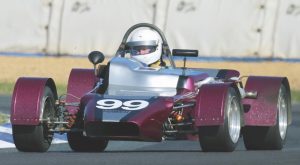 As of the time of writing, in 2020, this is the car I'm racing now. The Europa experience told me that I will only be satisfied by going as fast as I can round a circuit in a car properly developed for helping me do just that.
As of the time of writing, in 2020, this is the car I'm racing now. The Europa experience told me that I will only be satisfied by going as fast as I can round a circuit in a car properly developed for helping me do just that.
For what will probably be my last competition car I chose, for the fourth time, a Clubman category sports-racing car and thus completed a full circle by returning to my roots. I already well knew that a Clubman would be relatively easy and inexpensive to look after, and would still offer the best race performance per dollar available in the whole of motor sport.
I felt fortunate to be able to purchase in 2017 an example with an excellent history, originally built and developed by a friend. It is the second of a small batch of sports-racing cars built by well-known veteran race engineer Dave Mawer in 1972 to the Clubman formula of the era. Race cars to this configuration are all fundamentally descendants since 1957 of the pioneering Lotus Seven, such as the one I raced in 1960. In the hands of Graeme McClintock this Mawer was very successful, twice winning the NSW state clubman championship and running second in the national championship including the clubman lap record at Winton in the late 1970s.
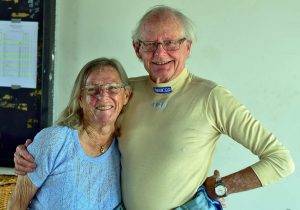 It now has a highly developed Ford-based engine producing about 150 bhp at the wheels, which is plenty for the lightweight chassis. I have done a fair bit of work on the setup, and it's now a peach to drive and seriously fast enough for me. I am now racing in the very popular supersprint category, with cars released to the circuit in practice time order. The winner is the competitor with the fastest lap time, and because lap times within the field are generally very similar the effect is that of a close race with a rolling start . This is easier on the car and safer than a standing start.
It now has a highly developed Ford-based engine producing about 150 bhp at the wheels, which is plenty for the lightweight chassis. I have done a fair bit of work on the setup, and it's now a peach to drive and seriously fast enough for me. I am now racing in the very popular supersprint category, with cars released to the circuit in practice time order. The winner is the competitor with the fastest lap time, and because lap times within the field are generally very similar the effect is that of a close race with a rolling start . This is easier on the car and safer than a standing start.
This is probably my last racing car, but Norma and I are still having a whole lot of fun!

